Enhancing the Definitions of Climate-Change Loss and Damage Based on Land Conversion in Florida, U.S.A.
Abstract
1. Introduction
The Role of Soils in Florida’s Actions to Reduce Greenhouse Gas (GHG) Emissions
| Stocks | Area | |
|---|---|---|
| Soil Order | General Characteristics and Constraints | (km2) |
| Slightly Weathered | 48,618.0 | |
| Entisols | Embryonic soils with an ochric epipedon | 29,900.8 |
| Inceptisols | Young soils with an ochric or umbric epipedon | 6946.3 |
| Histosols | Organic soils with ≥20% organic carbon | 11,770.8 |
| Moderately Weathered | 20,810.8 | |
| Alfisols | Clay-enriched B horizon with B.S. ≥35% | 15,372.5 |
| Mollisols | Carbon-enriched soils with B.S. ≥50% | 5438.3 |
| Strongly Weathered | 58,525.5 | |
| Spodosols | Coarse-textured soils with albic and spodic horizons | 27,984.5 |
| Ultisols | Highly leached soils with B.S. <35% | 30,541.0 |
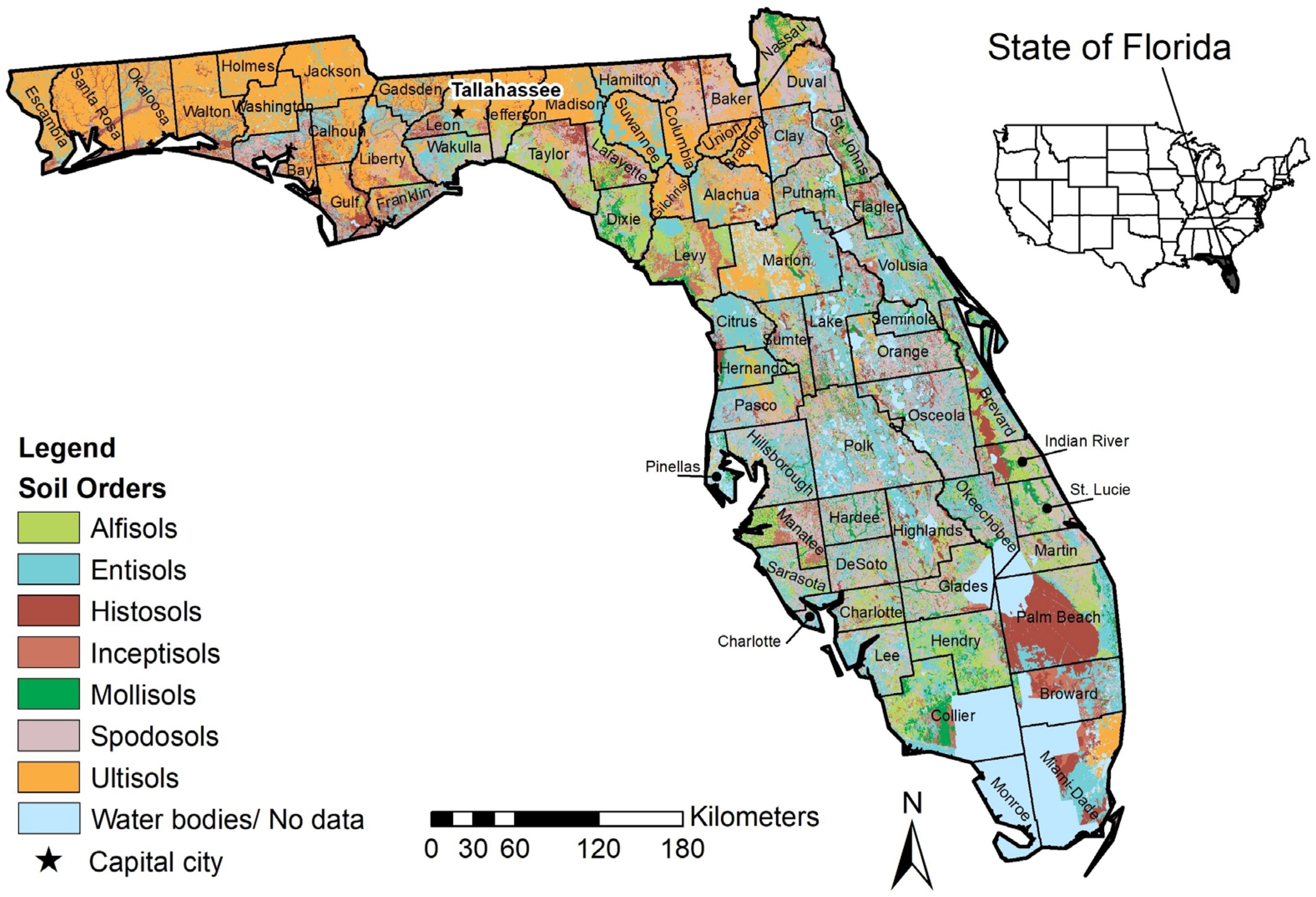
2. Materials and Methods
3. Results
3.1. Storage and Value of SOC by Soil Order and County for Florida
3.2. Storage and Value of SIC by Soil Order and County for Florida
3.3. Storage and Value of TSC (SOC + SIC) by Soil Order and County for Florida
3.4. Land Use/Land Cover Change in Florida by Soil Order from 2001 to 2016
4. Discussion
4.1. Significance of Results for Florida’s Actions to Reduce Greenhouse Gas (GHG) Emissions and Loss and Damage (L&D) from Land Developments
- (1)
- Loss and damage of land for soil carbon (C) sequestration potential because of land developments in the state of FL (USA), with a total of 20,249.6 km2 converted to developments prior and through 2016 (Table S3). Counties with some of the largest area losses to developments were Palm Beach County (1139.9 km2), Hillsborough (1001.7 km2), and Lee (900.5 km2). New developments from 2001 to 2016 resulted in a total of 1676.3 km2 converted to developments. Counties with some of the largest area losses to developments were Orange (137.4 km2), Hillsborough (105.9 km2), and Lee (96.3 km2). Most of the developments occurred around existing urban areas at the expense of forests and cultivated areas (Figure 6).
- (2)
- Loss and damage of soil carbon (C) because of land developments prior and through 2016 in the state of Florida (USA) with a midpoint total of 3.0 × 1011 kg in C losses (Table S3). Counties with some of the highest soil C losses were Palm Beach (2.3 × 1010 kg C), Broward (1.6 × 1010 kg C), and Orange (1.5 × 1010 kg C). New developments from 2001 to 2016 resulted in a total of 2.7 × 1010 kg in C losses. Counties with some of the highest soil C losses were Orange (2.5 × 109 kg C) and Miami-Dade (2.4 × 109 kg C) (Figure 7).
- (3)
- Loss and damage associated with the “realized” social costs of soil carbon (C) (SC-CO2) because of land developments prior and through 2016 in the state of FL (USA) with a midpoint total of $50.3B SC-CO2 (Table S3). Counties with some of the highest costs were Palm Beach ($3.8B), Broward ($2.6B), and Orange ($2.5B). New developments from 2001 to 2016 resulted in $4.5B SC-CO2. Counties with some of the highest costs were Orange ($417.5M), Miami-Dade ($411.3M), and Palm Beach ($255.7M) (Figure 8).
4.2. Significance of Results in Florida’s Loss and Damage (L&D) from Climate Change
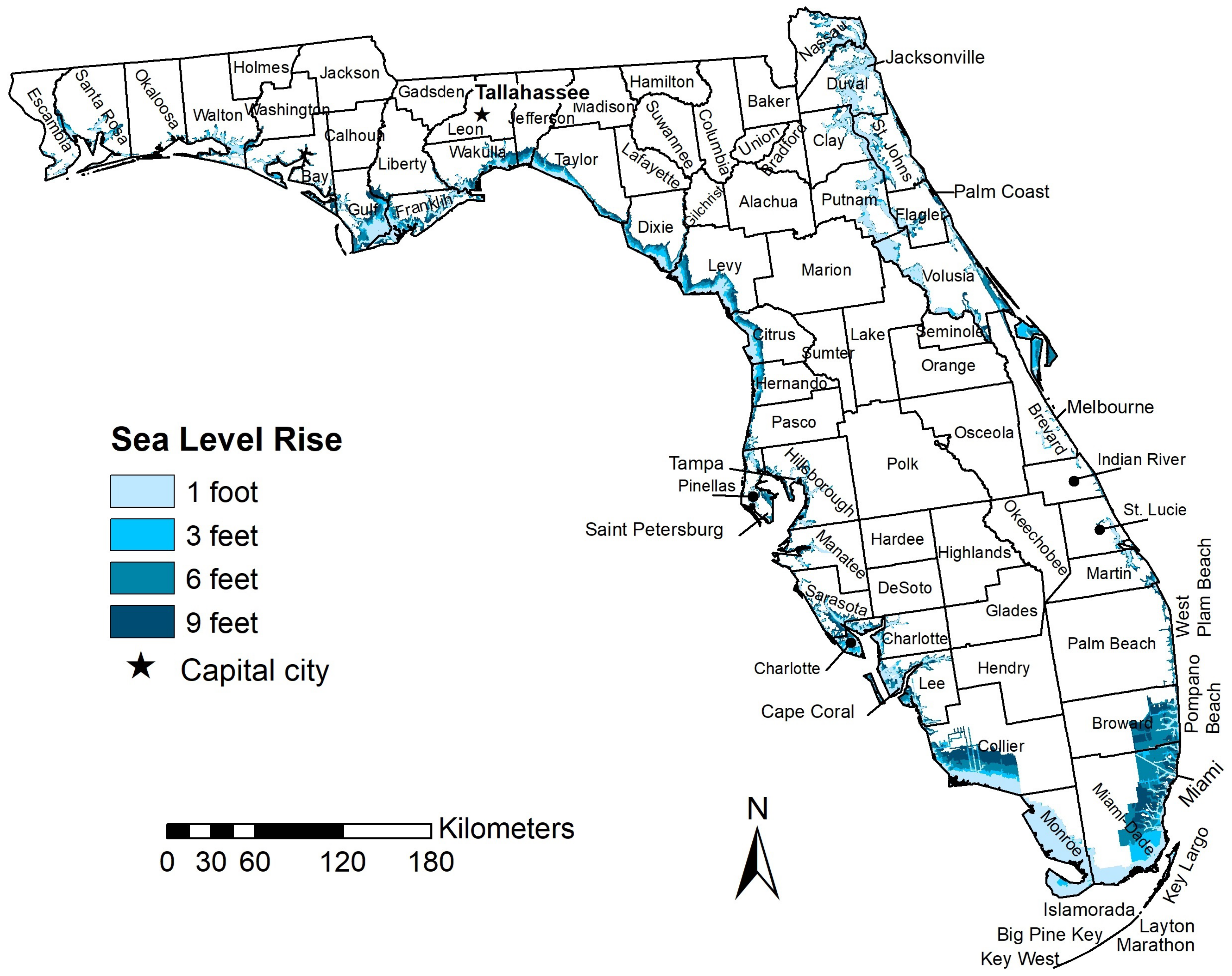
| Selected Counties (Affected by Sea Rise) | County Area Loss due to Sea Rise (%) | |||
|---|---|---|---|---|
| 1 foot | 3 feet | 6 feet | 9 feet | |
| Citrus | 5.7 | 10.9 | 15.4 | 18.9 |
| Clay | 6.0 | 6.9 | 7.9 | 9.3 |
| Collier | 6.8 | 9.9 | 15.7 | 23.5 |
| Dixie | 5.6 | 11.0 | 17.1 | 21.6 |
| Duval | 11.5 | 13.3 | 15.6 | 18.5 |
| Franklin | 8.6 | 15.9 | 21.8 | 31.2 |
| Gulf | 7.6 | 15.8 | 23.3 | 32.6 |
| Lee | 3.1 | 6.5 | 13.4 | 22.0 |
| Levy | 6.5 | 10.8 | 15.6 | 20.8 |
| Miami-Dade | 8.2 | 16.8 | 29.3 | 41.7 |
| Monroe | 42.2 | 51.8 | 52.3 | 52.6 |
| Pinellas | 4.8 | 7.2 | 16.4 | 23.9 |
| Putnam | 12.2 | 13.8 | 15.2 | 17.0 |
| St. Johns | 10.6 | 12.9 | 15.4 | 18.4 |
| Taylor | 3.4 | 6.5 | 10.3 | 13.6 |
| Volusia | 11.2 | 14.7 | 19.0 | 23.5 |
| Wakulla | 5.7 | 8.5 | 14.3 | 19.7 |
| NLCD Land Cover Classes (LULC) | 2016 Total Area by LULC (km2) | Degree of Weathering and Soil Development | ||||||
|---|---|---|---|---|---|---|---|---|
| Slight | Moderate | Strong | ||||||
| Entisols | Inceptisols | Histosols | Alfisols | Mollisols | Spodosols | Ultisols | ||
| 2016 Area by Soil Order (km2) | ||||||||
| Barren land | 617.3 | 296.2 | 19.2 | 27.2 | 34.1 | 9.6 | 159.2 | 71.8 |
| Woody wetlands | 34,436.8 | 5111.5 | 3152.8 | 5823.5 | 5155.4 | 3201.2 | 6427.2 | 5565.2 |
| Shrub/Scrub | 6518.0 | 1533.9 | 138.1 | 49.1 | 452.2 | 52.5 | 1606.4 | 2685.6 |
| Mixed forest | 1079.9 | 245.8 | 30.7 | 7.9 | 101.0 | 17.0 | 283.0 | 394.7 |
| Deciduous forest | 621.2 | 92.6 | 18.8 | 7.3 | 62.0 | 9.6 | 186.3 | 244.7 |
| Herbaceous | 4226.9 | 1186.0 | 98.6 | 46.4 | 380.3 | 39.7 | 827.0 | 1648.9 |
| Evergreen forest | 25,882.6 | 5516.2 | 1002.0 | 396.0 | 2317.4 | 304.3 | 5532.0 | 10,814.6 |
| Emergent herbaceous wetlands | 8422.2 | 1742.1 | 952.4 | 2771.1 | 1108.4 | 705.8 | 943.9 | 198.6 |
| Hay/Pasture | 16,583.3 | 4387.1 | 593.5 | 319.2 | 2526.8 | 431.0 | 5559.9 | 2765.8 |
| Cultivated crops | 9316.4 | 2059.7 | 179.6 | 1891.4 | 1255.1 | 233.1 | 1376.4 | 2321.0 |
| Developed, open space | 10,187.2 | 3462.0 | 393.9 | 226.7 | 1094.4 | 211.0 | 2563.8 | 2235.4 |
| Developed, medium intensity | 2930.0 | 1317.3 | 108.3 | 64.3 | 251.2 | 71.6 | 704.6 | 412.7 |
| Developed, low intensity | 6254.8 | 2564.2 | 234.2 | 121.5 | 574.7 | 131.5 | 1612.2 | 1016.5 |
| Developed, high intensity | 877.6 | 386.2 | 24.2 | 19.1 | 59.5 | 20.2 | 202.8 | 165.5 |
| Totals | 127,954.3 | 29,900.8 | 6946.3 | 11,770.8 | 15,372.5 | 5438.3 | 27,984.5 | 30,541.0 |
4.3. Significance of Results in a Broader Context
4.3.1. Enhancing the Definitions of Climate-Change Loss and Damage (L&D)
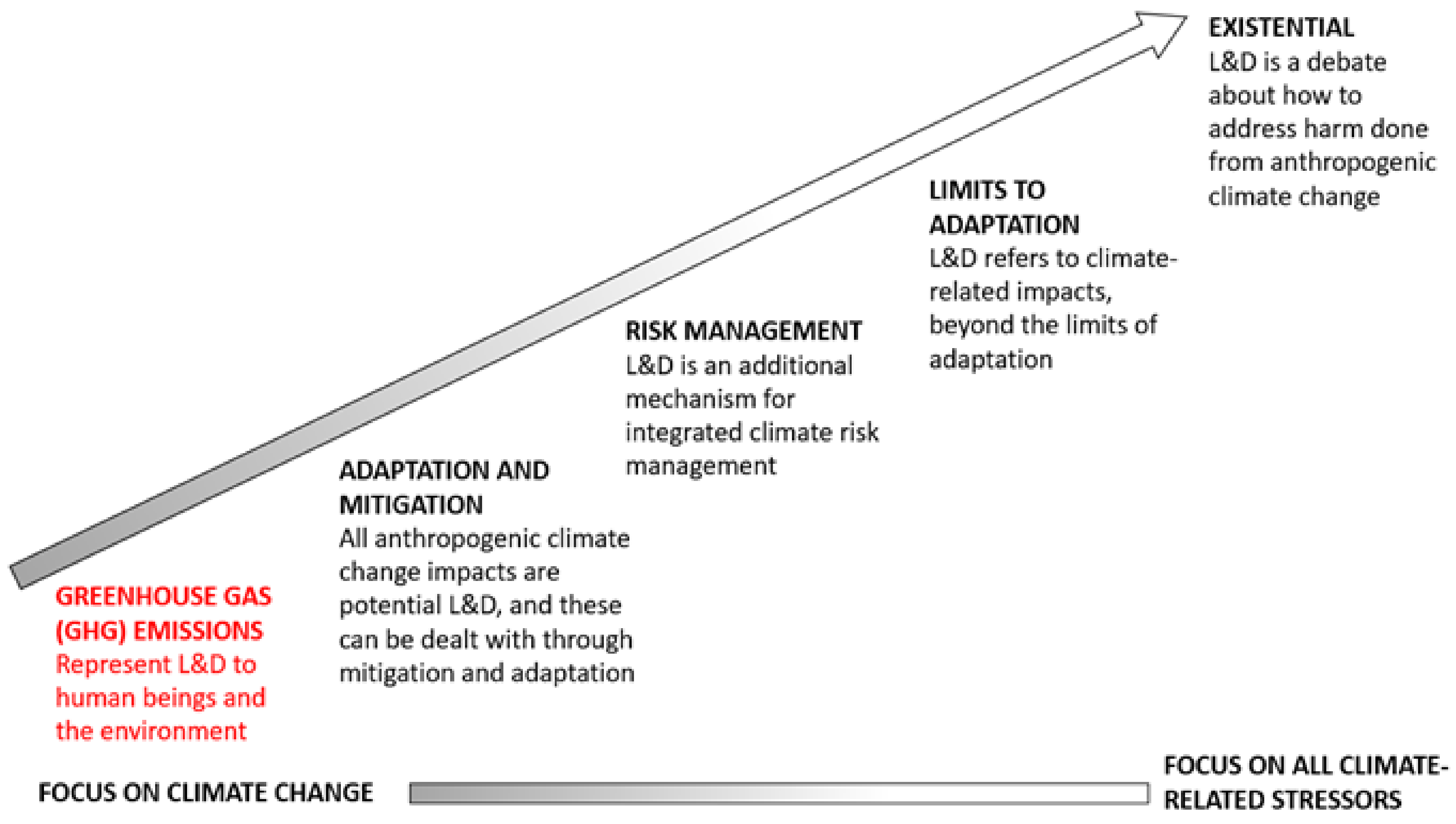
4.3.2. The “Moral Hazard” Issues Related to Loss and Damage (L&D)
5. Conclusions
Supplementary Materials
Author Contributions
Funding
Institutional Review Board Statement
Informed Consent Statement
Data Availability Statement
Acknowledgments
Conflicts of Interest
Glossary
| BS | Base saturation |
| CF | Carbon footprint |
| CCA | Climate Change Adaptation |
| CO2 | Carbon dioxide |
| COP | Conference of the Parties |
| ED | Ecosystem disservices |
| ES | Ecosystem services |
| EPA | Environmental Protection Agency |
| FL | Florida |
| GHG | Greenhouse Gases |
| L&D | Loss and damage |
| LULC | Land use/land cover |
| NOAA | National Oceanic and Atmospheric Administration |
| NRCS | Natural Resources Conservation Service |
| PPP | Polluter-pays-principle |
| RCCA | Reverse Climate Change Adaptation |
| SC-CO2 | Social cost of carbon emissions |
| SDGs | Sustainable Development Goals |
| SOC | Soil organic carbon |
| SIC | Soil inorganic carbon |
| SOM | Soil organic matter |
| SSURGO STATSGO | Soil Survey Geographic Database State Soil Geographic Database |
| TSC | Total soil carbon |
| USDA | United States Department of Agriculture |
| WIM | Warsaw International Mechanism |
References
- Vanhala, L.; Hestbaek, C. Framing climate change loss and damage in UNFCCC negotiations. Glob. Environ. Polit. 2016, 16, 111–129. [Google Scholar] [CrossRef]
- United Nations. Paris Agreement. 2015. Available online: https://unfccc.int/sites/default/files/english_paris_agreement.pdf (accessed on 30 November 2022).
- UN Climate Press Release. COP27 Reaches Breakthrough Agreement on New “Loss and Damage” Fund for Vulnerable Countries. 20 November 2022. Available online: https://unfccc.int/news/cop27-reaches-breakthrough-agreement-on-new-loss-and-damage-fund-for-vulnerable-countries (accessed on 30 November 2022).
- Martyr-Koller, R.; Thomas, A.; Schleussner, C.F.; Nauels, A.; Lissner, T. Loss and damage implications of sea-level rise on Small Island Developing States. Curr. Opin. Environ. Sustain. 2021, 50, 245–259. [Google Scholar] [CrossRef]
- Clarke, B.; Otto, F.; Stuart-Smith, R.; Harrington, L. Extreme weather impacts of climate change: An attribution perspective. Environ. Res. Clim. 2022, 1, 012001. [Google Scholar] [CrossRef]
- Bouwer, L.M. Observed and Projected Impacts from Extreme Weather Events: Implications for Loss and Damage. In Loss and Damage from Climate Change; Climate Risk Management, Policy and Governance; Mechler, R., Bouwer, L., Schinko, T., Surminski, S., Linnerooth-Bayer, J., Eds.; Springer: Cham, Switzerland, 2019. [Google Scholar] [CrossRef]
- Lai, M.; Robinson, S.A.; Salas, E.; Thao, W.; Shorb, A. Climate justice for small island developing states: Identifying appropriate international financing mechanisms for loss and damage. Clim. Policy 2022, 22, 1213–1224. [Google Scholar] [CrossRef]
- Bhandari, P.; Warszawski, N.; Cogan, D.; Gerholdt, R. What Is “Loss and Damage” from Climate Change? 6 Key Questions, Answered. World Resources Institute. 2022. Available online: https://www.wri.org/insights/loss-damage-climate-change (accessed on 30 November 2022).
- State of Florida Executive Order No. 07-127. Establishing Immediate Actions to Reduce Greenhouse Gas Emissions within Florida. Available online: https://www.fsec.ucf.edu/en/media/enews/2007/pdf/07-127-emissions.pdf (accessed on 30 November 2022).
- Governor’s Action Team on Energy and Climate Change. Florida’s Energy & Climate Change Action Plan. 15 October 2008. Available online: https://drought.unl.edu/archive/plans/Climate/state/FL_2008.pdf (accessed on 30 November 2022).
- Soil Science Society of America. n.d. USDA. Myakka—Florida State Soil. Available online: https://www.soils4teachers.org/files/s4t/k12outreach/fl-state-soil-booklet.pdf (accessed on 1 December 2022).
- Mikhailova, E.A.; Zurqani, H.A.; Post, C.J.; Schlautman, M.A.; Post, C.J. Soil diversity (pedodiversity) and ecosystem services. Land 2021, 10, 288. [Google Scholar] [CrossRef]
- Soil Survey Staff; Natural Resources Conservation Service; United States Department of Agriculture. n.d.a.; Soil Survey Geographic (SSURGO) Database. Available online: https://nrcs.app.box.com/v/soils (accessed on 10 September 2021).
- The United States Census Bureau. TIGER/Line Boundary Shapefiles. 2018. Available online: https://www.census.gov/geographies/mapping-files/time-series/geo/tiger-line-file.2018.html (accessed on 10 September 2022).
- EPA—United States Environmental Protection Agency. What Climate Change Means for Florida. EPA 430-F-16-011. August 2016. Available online: https://digital.library.unt.edu/ark:/67531/metadc949070/ (accessed on 5 December 2022).
- Reyes, M. Hurricane Ian Will Cost US Insurers $63 Billion, Risk Modeler Says. Bloomberg. September 2022. Available online: https://www.bloomberg.com/news/articles/2022-09-30/hurricane-ian-to-cost-us-insurers-63-billion-risk-modeler-says (accessed on 5 December 2022).
- Sklar, F.H.; Carlson, C.; Coronado-Molina, C.; Maran, A.C. Coastal ecosystem vulnerability and sea level rise (SLR) in South Florida: A mangrove transition projection. Front. Ecol. Evol. 2021, 9, 1–17. [Google Scholar] [CrossRef]
- Sullivan, B. Florida’s Population has Skyrocketed. That could Make Hurricane Ian more Destructive. National Public Radio (NPR). Available online: https://www.npr.org/2022/09/28/1125469629/hurricane-ian-florida-cost (accessed on 5 December 2022).
- U.S. Bureau of the Census. Statistical Abstract of the United States: 1991. Washington, DC. 1991; p. 201. Available online: https://www.census.gov/library/publications/1991/compendia/statab/111ed.html (accessed on 10 December 2021).
- Sea Level Rise Viewer by the U.S. National Oceanic and Atmospheric Administration. Available online: https://coast.noaa.gov/digitalcoast/tools/slr.html (accessed on 5 December 2022).
- ESRI Hurricane Ian National Oceanic and Atmospheric Administration Imagery Viewer. Available online: https://disasterresponse.maps.arcgis.com/apps/instant/media/index.html?appid=4debf5ef1d4c493489f8c9de66107931 (accessed on 5 December 2022).
- EPA—United States Environmental Protection Agency. The Social Cost of Carbon. EPA Fact Sheet. 2016. Available online: https://19january2017snapshot.epa.gov/climatechange/social-cost-carbon_.html (accessed on 15 September 2022).
- Guo, Y.; Amundson, R.; Gong, P.; Yu, Q. Quantity and spatial variability of soil carbon in the conterminous United States. Soil Sci. Soc. Am. J. 2006, 70, 590–600. [Google Scholar] [CrossRef]
- Groshans, G.R.; Mikhailova, E.A.; Post, C.J.; Schlautman, M.A.; Zhang, L. Determining the value of soil inorganic carbon stocks in the contiguous United States based on the avoided social cost of carbon emissions. Resources 2019, 8, 119. [Google Scholar] [CrossRef]
- Multi-Resolution Land Characteristics Consortium—MRLC. Available online: https://www.mrlc.gov/ (accessed on 1 September 2021).
- ESRI (Environmental Systems Research Institute). ArcGIS Pro 2.6. Available online: https://pro.arcgis.com/en/pro-app/2.6/get-started/whats-new-in-arcgis-pro.htm (accessed on 1 March 2022).
- Mikhailova, E.A.; Groshans, G.R.; Post, C.J.; Schlautman, M.A.; Post, C.J. Valuation of total soil carbon stocks in the contiguous United States based on the avoided social cost of carbon emissions. Resources 2019, 8, 157. [Google Scholar] [CrossRef]
- Mikhailova, E.A.; Groshans, G.R.; Post, C.J.; Schlautman, M.A.; Post, G.C. Valuation of soil organic carbon stocks in the contiguous United States based on the avoided social cost of carbon emissions. Resources 2019, 8, 153. [Google Scholar] [CrossRef]
- Soil Survey Staff; Natural Resources Conservation Service; United States Department of Agriculture. Photos of Soil Orders. Available online: https://www.nrcs.usda.gov/wps/portal/nrcs/detail/soils/edu/?cid=nrcs142p2_053588 (accessed on 20 September 2022).
- National Oceanic and Atmospheric Administration (NOAA). Climate.gov. Available online: https://www.climate.gov/maps-data (accessed on 2 October 2022).
- Roberts, D. Florida’s Fatal Attraction. The Atlantic. 2022. Available online: https://www.theatlantic.com/ideas/archive/2022/10/florida-hurricane-ian-damage-desantis/671630/ (accessed on 10 December 2022).
- Bruggers, J.; Green, A. Florida Commits $1 Billion to Climate Resilience. But After Hurricane Ian, Some Question the State’s Development Practices. 2022. Inside Climate News. Available online: https://insideclimatenews.org/news/08102022/florida-commits-1-billion-to-climate-resilience-but-after-hurricane-ian-some-question-the-states-development-practices/ (accessed on 10 December 2022).
- Grabar, H. What Happens When You Add a Hurricane Crisis to an Insurance Crisis? Slate. 2022. Available online: https://slate.com/business/2022/10/florida-hurricane-ian-insurance-homeowners-crisis.html (accessed on 10 December 2022).
- Mower, L. Florida Lawmakers Reveal Proposed Changes to Property Insurance Laws. Miami Herald. 2022. Available online: https://www.miamiherald.com/news/politics-government/state-politics/article269839242.html (accessed on 12 December 2022).
- Burger, M.; Wentz, J.; Horton, R. The law and science of climate change attribution. Columbia J. Environ. Law 2020, 45, 57–240. [Google Scholar]
- Baldrich, R. The Role of Climate Science in Litigation against Carbon Majors. ISIpedia. 2021. Available online: https://www.isipedia.org/story/the-role-of-climate-science-in-litigation-against-carbon-majors/ (accessed on 12 December 2022).
- Mikhailova, E.A.; Lin, L.; Hao, Z.; Zurqani, H.A.; Post, C.J.; Schlautman, M.A.; Post, G.C.; Shepherd, G.B. Delaware’s Climate Action Plan: Omission of source attribution from land conversion emissions. Laws 2022, 11, 41. [Google Scholar] [CrossRef]
- Roberts, J.T.; Natson, S.; Hoffmeister, V.; Durand, A.; Weikmans, R.; Gewirtzman, J.; Huq, S. How will we pay for loss and damage? Ethics Policy Environ. 2017, 20, 208–226. [Google Scholar] [CrossRef]
- Khan, M.R. Polluter-pays-principle: The cardinal instrument for addressing climate change. Laws 2015, 4, 638–653. [Google Scholar] [CrossRef]
- Palekienė, O.; Bruneckienė, J.; Simanavičienė, Ž. Critical analysis of loss and damage concepts under process of economic 720 assessment. Procedia-Soc. Behav. Sci. 2014, 156, 304–309. [Google Scholar] [CrossRef]
- Broberg, M.; Romera, B.M. Loss and damage after Paris: More bark than bite? Clim. Policy 2020, 20, 661–668. [Google Scholar] [CrossRef]
- Zhai, T. Double-faceted environmental civil liability and the separate-regulatory paradigm: An inspiration for China. Sustainability 2022, 14, 4369. [Google Scholar] [CrossRef]
- Van der Geest, K.; Warner, K. Loss and damage from climate change: Emerging perspectives. Int. J. Glob. Warm. 2015, 8, 133–140. [Google Scholar]
- Doelle, M.; Seck, S. Loss and damage from climate change: From concept to remedy? Clim. Policy 2020, 20, 669–680. [Google Scholar] [CrossRef]
- Boyd, E.; Chaffin, B.C.; Dorkenoo, K.; Jackson, G.; Harrington, L.; N’Guetta, A.; Johansson, E.L.; Nordlander, L.; De Rosa, S.P.; Raju, E.; et al. Loss and damage from climate change: A new climate justice agenda. One Earth 2021, 4, 1365–1370. [Google Scholar] [CrossRef]
- Mechler, R.; Calliari, E.; Bouwer, L.M.; Schinko, T.; Surminski, S.; Linnerooth-Bayer, J.; Huggel, C.; Wallimann-Helmer, I. Science for Loss and Damage. Findings and Propositions. In Loss and Damage from Climate Change; Mechler, R., Bouwer, T.S., Surminski, S., Linnerooth-Bayer, J., Eds.; Springer Open: Cham, Switzerland, 2019; Chapter 1; pp. 3–38. [Google Scholar]
- Van den Homberg, M.; McQuistan, C. Technology for Climate Justice: A Reporting Framework for Loss and Damage as Part of Key Global Agreements. In Loss and Damage from Climate Change; Mechler, R., Bouwer, T.S., Surminski, S., Linnerooth-Bayer, J., Eds.; Springer Open: Cham, Switzerland, 2019; Chapter 22; pp. 513–545. [Google Scholar] [CrossRef]
- Schäfer, L.; Balogun, K. Stocktaking of Cimate Risk Assessment Approaches Related to Loss and Damage; UNUEHS Working Paper, No. 20; United Nations University Institute of Environment and Human Security: Bonn, Germany, 2015; Available online: https://collections.unu.edu/eserv/UNU:3300/Stocktaking_of_climate_risk_WP_No_20.pdf (accessed on 15 January 2023).
- Loss and Damage Financing Must Push beyond Market-Based Measures. Climate Analytics. 29 January 2018. 736. Available online: http://theenergymix.com/2018/01/29/loss-and-damage-financing-must-push-beyond-market-based-measures/ (accessed on 15 January 2023).
- Verheyen, R.; Roderick, P. Beyond Adaptation—The Legal Duty to Pay Compensation for Climate Change Damage; Climate Change Programme Discussion Paper; WWF-UK: Surrey, UK, 2008; p. 2008. [Google Scholar]
- Bagenstose, K. A climate reckoning for US housing: Too many homes in harm’s way, ‘too many zeros’ in the costs. USA Today, 5 November 2022.
- Supran, G.; Rahmstorf, S.; Oreskes, N. Assessing ExxonMobil’s Global Warming Projections. Science 2023, 379, 1–9. [Google Scholar] [CrossRef] [PubMed]
- Greta Thunberg Sues Sweden for Climate Inaction, But Have Climate Change Lawsuits Made Any Impact? Outlook. 25 November 2022. Available online: https://www.outlookindia.com/international/greta-thunberg-sues-sweden-for-climate-inaction-but-have-climate-change-lawsuits-made-any-impact--news-240153 (accessed on 15 January 2023).
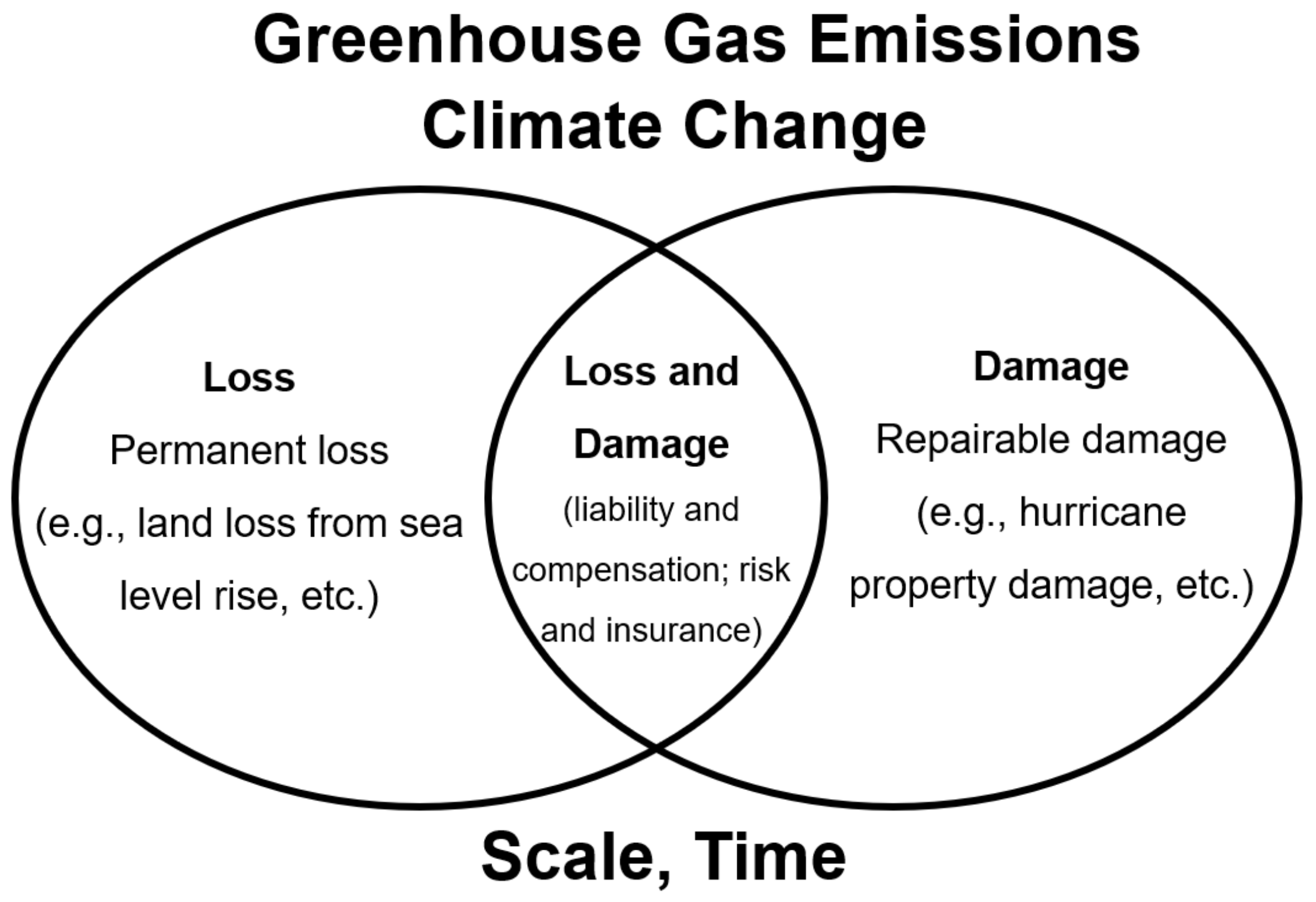
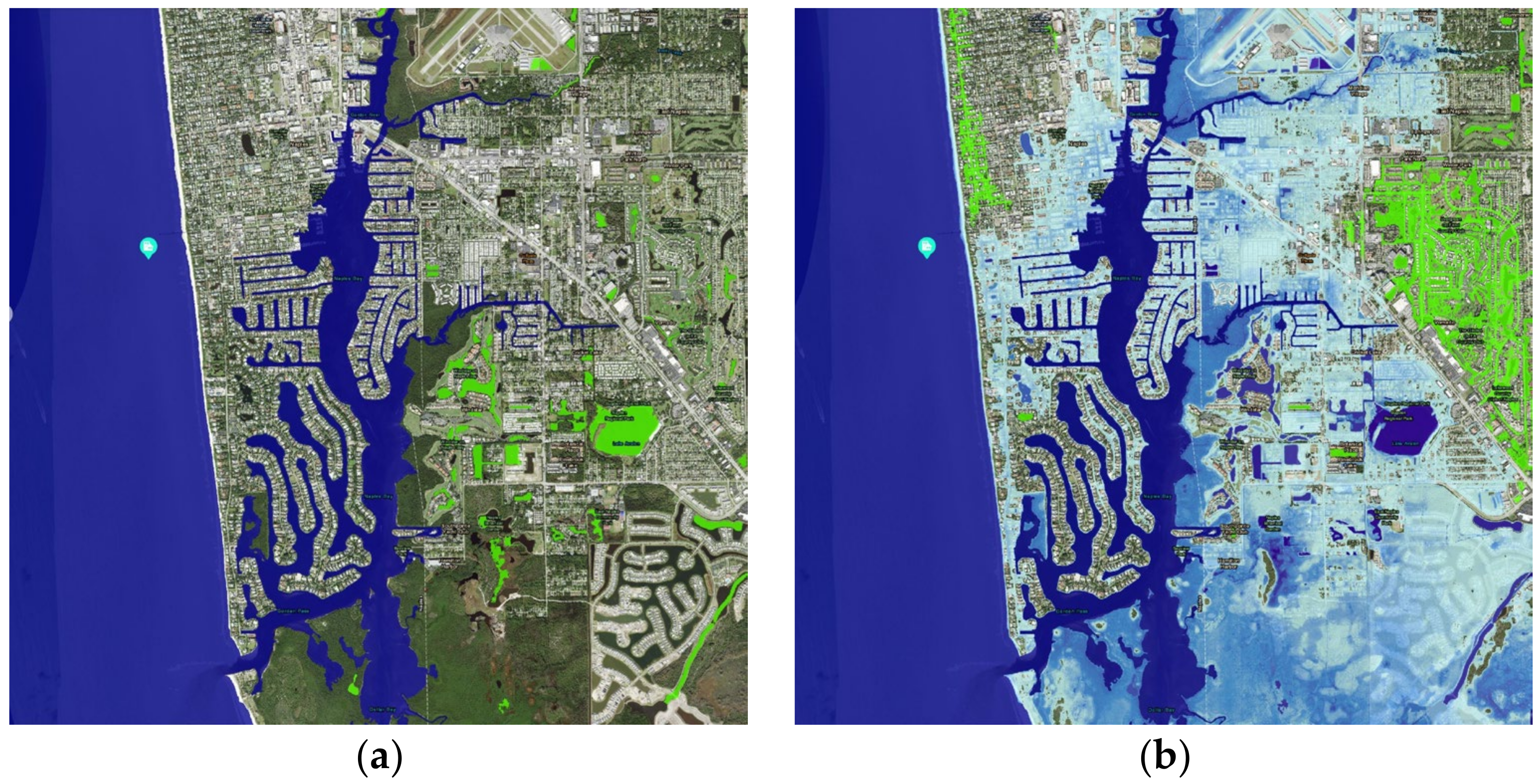
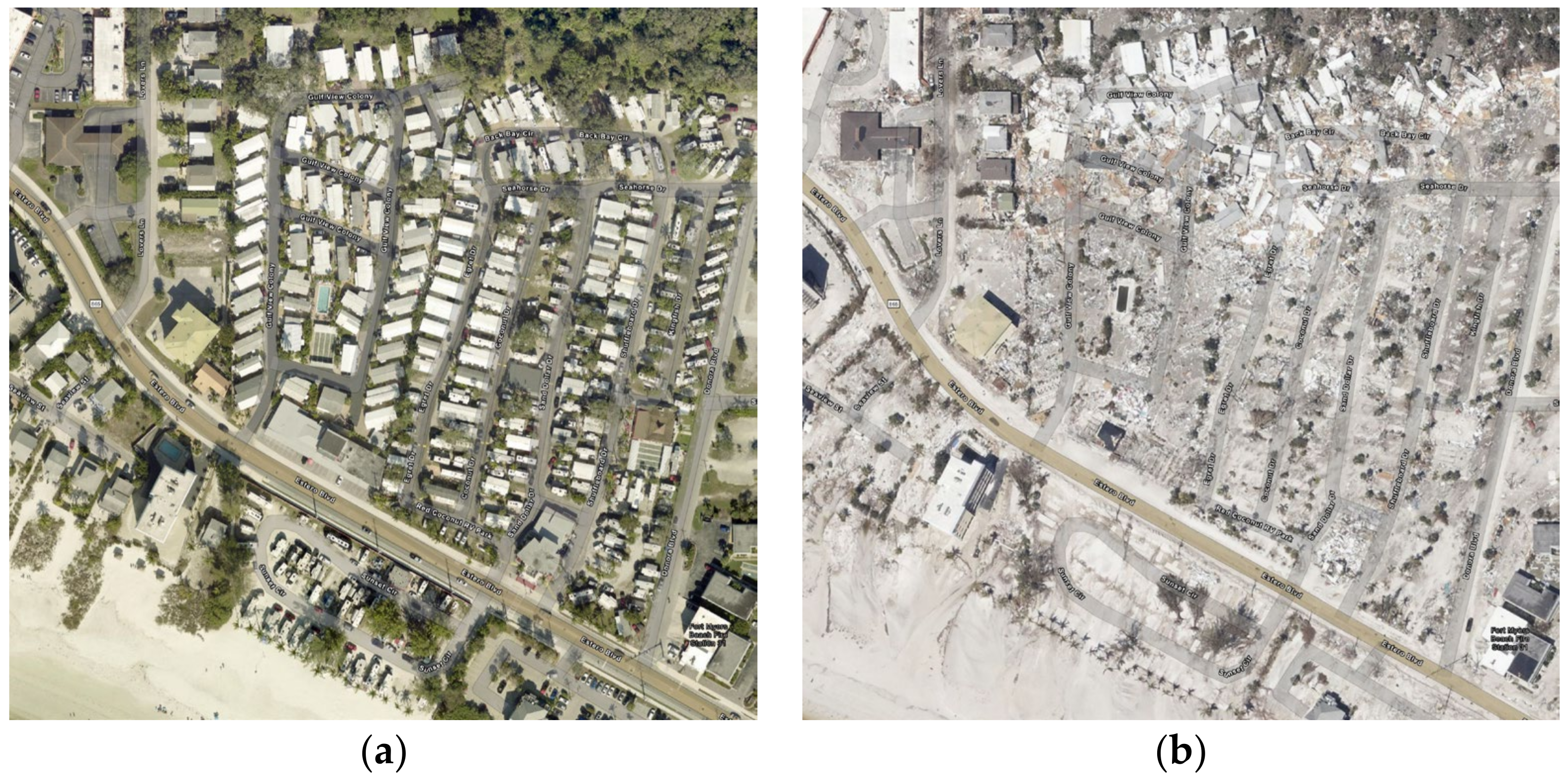
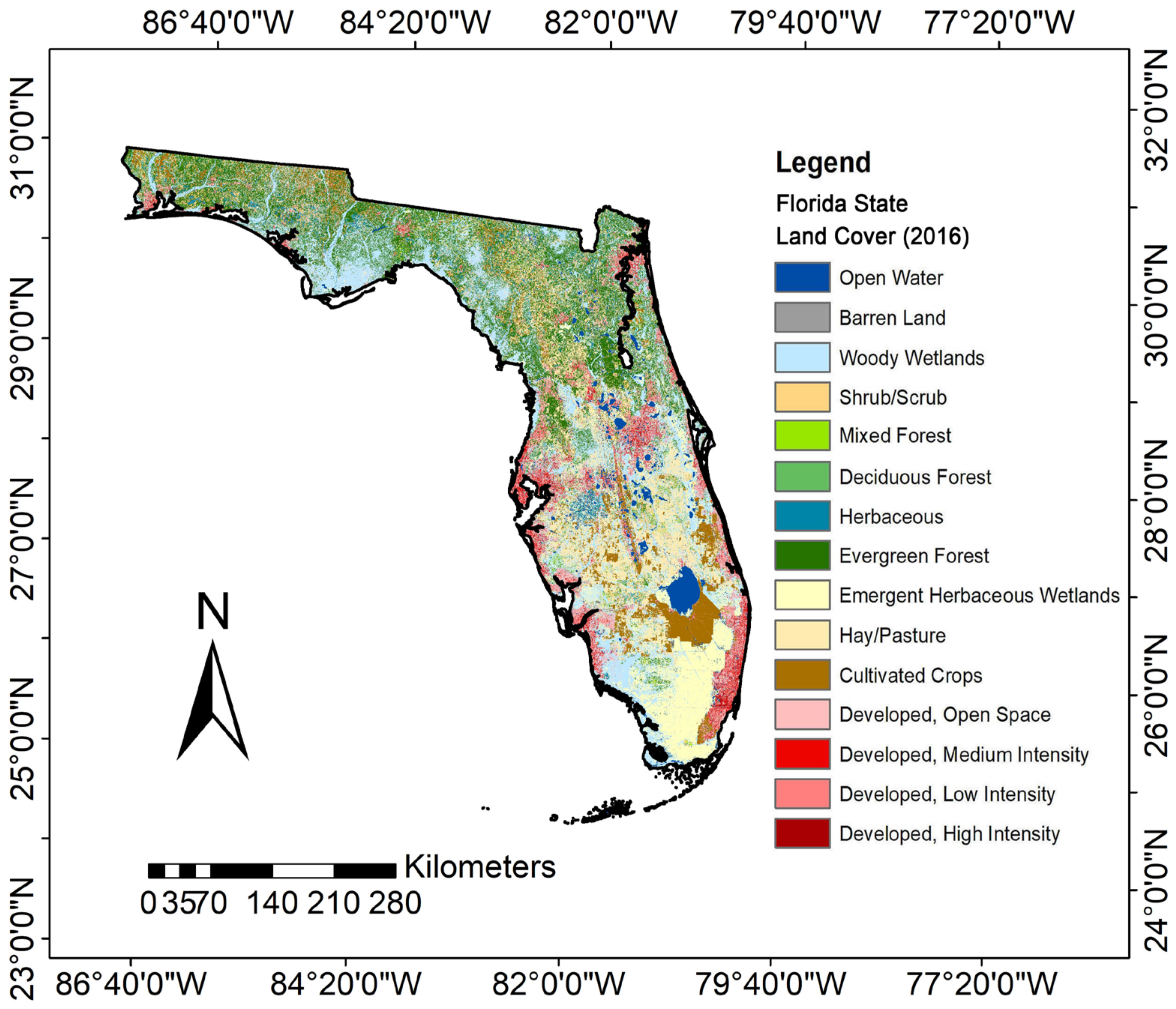
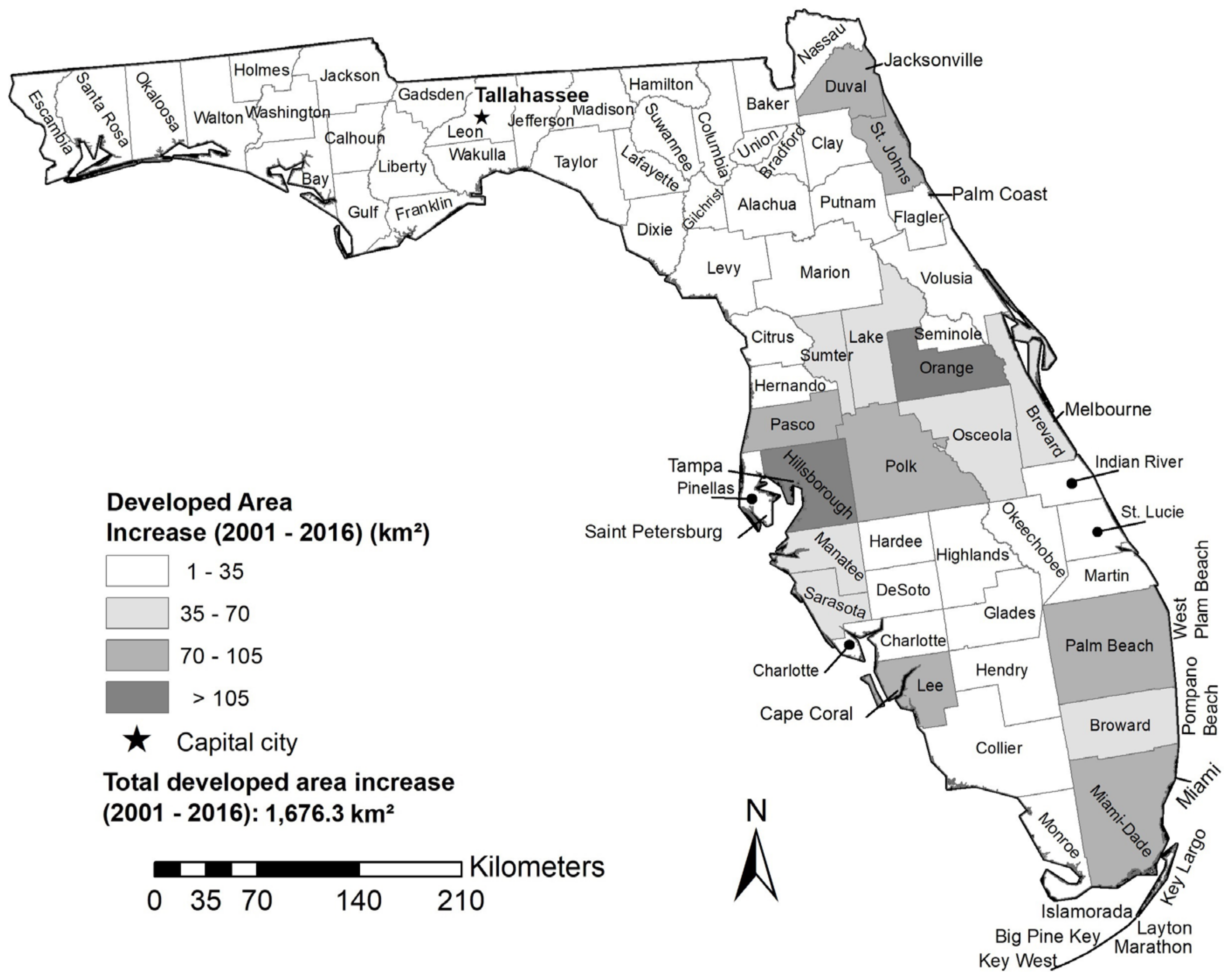
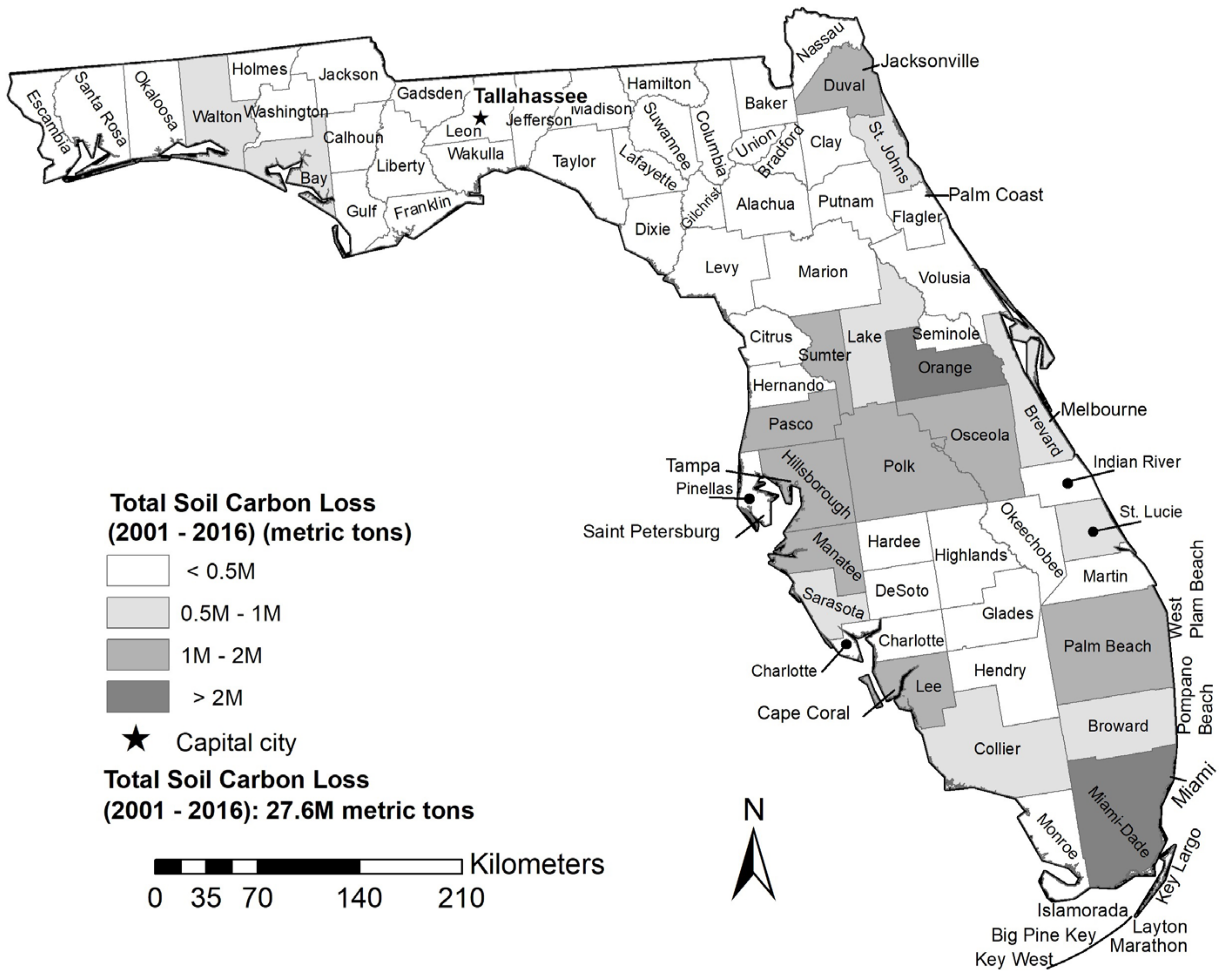
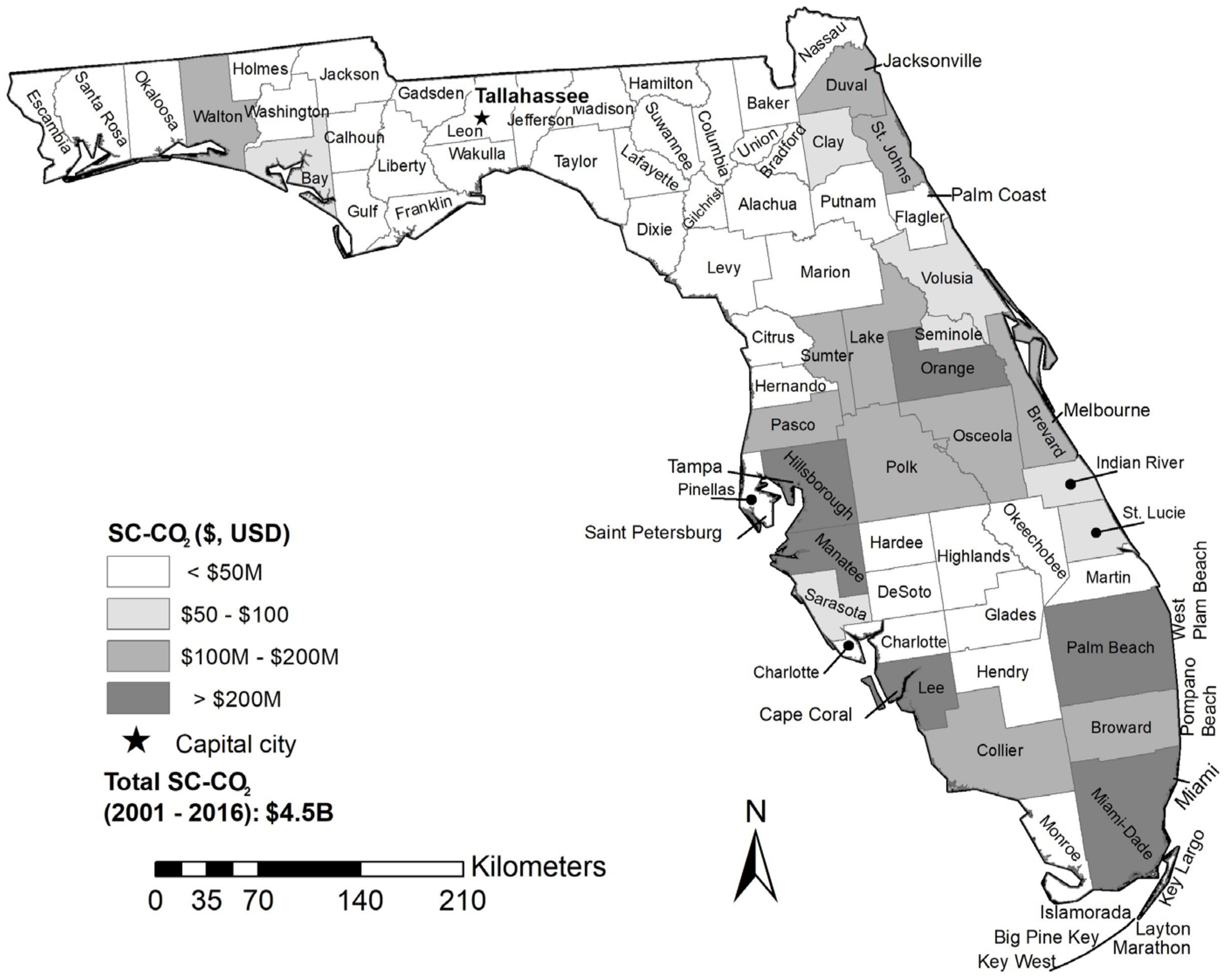
OWNERSHIP (e.g., government, private, foreign, shared, single, etc.) | |||||
| Time (e.g., information disclosure, etc.) | STOCKS/SOURCE ATTRIBUTION | FLOWS | VALUE | ||
| Biophysical Accounts (Science-Based) | Administrative Accounts (Boundary-Based) | Monetary Account(s) | Benefit(s)/ Damages | Total Value | |
| Soil extent: | Administrative extent: | Ecosystem good(s) and service(s): | Sector: | Types of value: | |
| Composite (total) stock: Total soil carbon (TSC) = Soil organic carbon (SOC) + Soil inorganic carbon (SIC) | |||||
| Past (e.g., post-development disclosures) Current (e.g., status) Future (e.g., pre-development disclosures) | Environment: | “Avoided” or “realized” social cost of carbon (SC-CO2) emissions: | |||
| - Soil orders (Entisols, Inceptisols, Histosols, Alfisols, Mollisols, Spodosols, Ultisols) | - State (Florida); - County (67 counties) | - Regulation (e.g., carbon sequestration); - Provisioning (e.g., food production) | - Carbon gain (sequestration); - Carbon loss | - $46 per metric ton of CO2 applicable for the year 2025 (2007 U.S. dollars with an average discount rate of 3% [22]) | |
| Conflicts of Interest (COI) | |||||
| Loss and Damage (L&D) | |||||
| Soil Order | SOC Content (kg m−2) SOC Value ($ m−2) | SIC Content (kg m−2) SIC Value ($ m−2) | TSC Content (kg m−2) TSC Value ($ m−2) |
|---|---|---|---|
| Minimum—Midpoint—Maximum Values | |||
| Entisols | 1.8—8.0—15.8 0.3—1.35—2.66 | 1.9—4.8—8.4 0.32—0.82—1.42 | 3.7—12.8—24.2 0.62—2.17—4.08 |
| Inceptisols | 2.8—8.9—17.4 0.47—1.50—2.93 | 2.5—5.1—8.4 0.42—0.86—1.42 | 5.3—14.0—25.8 0.89—2.36—4.35 |
| Histosols | 63.9—140.1—243.9 10.78—23.62—41.14 | 0.6—2.4—5.0 0.10—0.41—0.84 | 64.5—142.5—248.9 10.88—24.03—41.98 |
| Alfisols | 2.3—7.5—14.1 0.39—1.27—2.38 | 1.3—4.3—8.1 0.22—0.72—1.37 | 3.6—11.8—22.2 0.61—1.99—3.74 |
| Mollisols | 5.9–13.5–22.8 1.00—2.28—3.85 | 4.9–11.5–19.7 0.83—1.93—3.32 | 10.8–25.0–42.5 1.82—4.21—7.17 |
| Spodosols | 2.9—12.3—25.5 0.49—2.07—4.30 | 0.2—0.6—1.1 0.03—0.10—0.19 | 3.1—12.9—26.6 0.52—2.17—4.49 |
| Ultisols | 1.9—7.1—13.9 0.32—1.20—2.34 | 0.0—0.0—0.0 0.00—0.00—0.00 | 1.9—7.1—13.9 0.32—1.20—2.34 |
| Soil Regulating Ecosystem Services in the State of Florida | ||||||
|---|---|---|---|---|---|---|
| Degree of Weathering and Soil Development | ||||||
| Slight 37% | Moderate 16% | Strong 46% | ||||
| Entisols | Inceptisols | Histosols | Alfisols | Mollisols | Spodosols | Ultisols |
| 23% | 5% | 9% | 12% | 4% | 22% | 24% |
 |  |  |  |  |  |  |
| Midpoint storage and social cost of soil organic carbon (SOC): 2.7 × 1012 kg C, $455.2B | ||||||
| 2.4 × 1011 kg | 6.2 × 1010 kg | 1.7 × 1012 kg | 1.2 × 1011 kg | 7.3 × 1010 kg | 3.4 × 1011 kg | 2.2 × 1011 kg |
| $40.4B | $10.4B | $278.0B | $19.5B | $12.4B | $57.9B | $36.6B |
| 9% | 2% | 61% | 4% | 3% | 13% | 8% |
| Midpoint storage and social cost of soil inorganic carbon (SIC): 3.5 × 1011 kg C, $59.6B | ||||||
| 1.4 × 1011 kg | 3.5 × 1010 kg | 2.8 × 1010 kg | 6.6 × 1010 kg | 6.3 × 1010 kg | 1.7 × 1010 kg | 0 |
| $24.5B | $6.0B | $4.8B | $11.0B | $10.5B | $2.8B | $0 |
| 41% | 10% | 8% | 19% | 18% | 5% | 0% |
| Midpoint storage and social cost of total soil carbon (TSC): 3.1 × 1012 kg C, $514.8B | ||||||
| 3.8 × 1011 kg | 9.7 × 1010 kg | 1.7 × 1012 kg | 1.8 × 1011 kg | 1.4 × 1011 kg | 3.6 × 1011 kg | 2.2 × 1011 kg |
| $64.9B | $16.4B | $282.8B | $30.9B | $22.9B | $60.7B | $36.6B |
| 13% | 3% | 55% | 6% | 4% | 12% | 7% |
| Sensitivity to climate change | ||||||
| Low | Low | High | High | High | Low | Low |
| SOC and SIC sequestration (recarbonization) potential | ||||||
| Low | Low | Low | Low | Low | Low | Low |
| NLCD Land Cover Classes (LULC) | Change in Area, 2001–2016 (%) | Degree of Weathering and Soil Development | ||||||
|---|---|---|---|---|---|---|---|---|
| Slight | Moderate | Strong | ||||||
| Entisols | Inceptisols | Histosols | Alfisols | Mollisols | Spodosols | Ultisols | ||
| Change in Area, 2001–2016 (%) | ||||||||
| Barren land | −0.8 | −3.5 | −5.4 | 122.9 | 5.0 | 16.8 | −5.3 | −2.9 |
| Woody wetlands | 1.1 | 0.3 | 0.5 | 2.8 | 2.1 | 1.6 | 0.7 | −0.1 |
| Shrub/Scrub | 14.5 | 8.3 | −4.7 | 6.0 | −1.4 | −3.1 | 4.7 | 31.6 |
| Mixed forest | −0.6 | 1.1 | 4.5 | −13.8 | 4.1 | 8.5 | 18.0 | −12.8 |
| Deciduous forest | 24.0 | 25.3 | 32.4 | 17.3 | 36.6 | 39.9 | 33.6 | 13.8 |
| Herbaceous | 5.4 | 15.9 | −8.3 | 10.0 | −5.8 | −21.1 | −6.7 | 10.2 |
| Evergreen forest | −5.0 | −7.3 | 1.0 | −0.3 | 1.3 | 4.4 | −4.1 | −6.3 |
| Emergent herbaceous wetlands | −8.1 | −5.9 | −5.4 | −6.9 | −13.2 | −9.6 | −11.6 | −4.5 |
| Hay/Pasture | −7.6 | −7.9 | −10.1 | −9.1 | −6.3 | −5.3 | −5.4 | −11.7 |
| Cultivated crops | 0.7 | 0.3 | 1.1 | −1.8 | −0.9 | −5.1 | −0.3 | 5.4 |
| Developed, open space | 2.4 | 1.3 | 4.8 | 4.4 | 3.5 | 3.3 | 3.4 | 2.0 |
| Developed, medium intensity | 31.1 | 26.2 | 41.4 | 36.5 | 45.1 | 27.8 | 38.6 | 25.2 |
| Developed, low intensity | 9.2 | 7.5 | 12.8 | 11.9 | 14.8 | 9.0 | 10.9 | 7.1 |
| Developed, high intensity | 31.5 | 26.9 | 64.7 | 55.7 | 51.9 | 39.8 | 42.2 | 18.3 |
| NLCD Land Cover Classes (LULC); Developed Area Increase between 2001 and 2016 (km2); Midpoint Complete Loss of Total Soil Carbon (kg); Midpoint SC-CO2 ($ = USD) | Degree of Weathering and Soil Development | ||||||
|---|---|---|---|---|---|---|---|
| Slight | Moderate | Strong | |||||
| Entisols | Inceptisols | Histosols | Alfisols | Mollisols | Spodosols | Ultisols | |
| Developed Area Increase between 2001 and 2016 (km2) Midpoint Complete Loss of Total Soil Carbon (kg) Midpoint SC-CO2 ($ = USD) | |||||||
| Developed, open space | 45.4 | 18.0 | 9.6 | 37.0 | 6.7 | 83.4 | 42.9 |
| 242.9 km2 (4.2 × 109 kg C) | 5.8 × 108 | 2.5 × 108 | 1.4 × 109 | 4.4 × 108 | 1.7 × 108 | 1.1 × 109 | 3.0 × 108 |
| $705.7M | $98.5M | $42.4M | $230.6M | $73.6M | $28.1M | $181.0M | $51.5M |
| Developed, medium intensity | 273.4 | 31.7 | 17.2 | 78.1 | 15.6 | 196.2 | 83.0 |
| 695.2 km2 (1.1 × 1010 kg C) | 3.5 × 109 | 4.4 × 108 | 2.4 × 109 | 9.2 × 108 | 3.9 × 108 | 2.5 × 109 | 5.9 × 108 |
| $1.8B | $593.3M | $74.9M | $412.7M | $155.4M | $65.6M | $425.7M | $99.6M |
| Developed, low intensity | 177.9 | 26.5 | 12.9 | 74.2 | 10.8 | 158.3 | 67.6 |
| 528.2 km2 (8.2 × 109 kg C) | 2.3 × 109 | 3.7 × 108 | 1.8 × 109 | 8.8 × 108 | 2.7 × 108 | 2.0 × 109 | 4.8 × 108 |
| $1.4B | $386.1M | $62.6M | $309.5M | $147.6M | $45.5M | $343.6M | $81.2M |
| Developed, high intensity | 81.8 | 9.5 | 6.8 | 20.3 | 5.8 | 60.2 | 25.6 |
| 210.0 km2 (3.5 × 109 kg C) | 1.0 × 109 | 1.3 × 108 | 9.8 × 108 | 2.4 × 108 | 1.4 × 108 | 7.8 × 108 | 1.8 × 108 |
| $590.5M | $177.5M | $22.4M | $164.6M | $40.4M | $24.2M | $130.6M | $30.7M |
| Totals | 578.5 | 85.7 | 46.5 | 209.6 | 38.8 | 498.1 | 219.1 |
| 1676.3 km2 (2.7 × 1010 kg C) | 7.4 × 109 | 1.2 × 109 | 6.6 × 109 | 2.5 × 109 | 9.7 × 108 | 6.4 × 109 | 1.6 × 109 |
| $4.5B | $1.3B | $202.3M | $1.1B | $417.1M | $163.4M | $1.1B | $263.0M |
Disclaimer/Publisher’s Note: The statements, opinions and data contained in all publications are solely those of the individual author(s) and contributor(s) and not of MDPI and/or the editor(s). MDPI and/or the editor(s) disclaim responsibility for any injury to people or property resulting from any ideas, methods, instructions or products referred to in the content. |
© 2023 by the authors. Licensee MDPI, Basel, Switzerland. This article is an open access article distributed under the terms and conditions of the Creative Commons Attribution (CC BY) license (https://creativecommons.org/licenses/by/4.0/).
Share and Cite
Mikhailova, E.A.; Lin, L.; Hao, Z.; Zurqani, H.A.; Post, C.J.; Schlautman, M.A.; Post, G.C.; Shepherd, G.B.; Kolarik, S.J. Enhancing the Definitions of Climate-Change Loss and Damage Based on Land Conversion in Florida, U.S.A. Urban Sci. 2023, 7, 40. https://doi.org/10.3390/urbansci7020040
Mikhailova EA, Lin L, Hao Z, Zurqani HA, Post CJ, Schlautman MA, Post GC, Shepherd GB, Kolarik SJ. Enhancing the Definitions of Climate-Change Loss and Damage Based on Land Conversion in Florida, U.S.A. Urban Science. 2023; 7(2):40. https://doi.org/10.3390/urbansci7020040
Chicago/Turabian StyleMikhailova, Elena A., Lili Lin, Zhenbang Hao, Hamdi A. Zurqani, Christopher J. Post, Mark A. Schlautman, Gregory C. Post, George B. Shepherd, and Sarah J. Kolarik. 2023. "Enhancing the Definitions of Climate-Change Loss and Damage Based on Land Conversion in Florida, U.S.A." Urban Science 7, no. 2: 40. https://doi.org/10.3390/urbansci7020040
APA StyleMikhailova, E. A., Lin, L., Hao, Z., Zurqani, H. A., Post, C. J., Schlautman, M. A., Post, G. C., Shepherd, G. B., & Kolarik, S. J. (2023). Enhancing the Definitions of Climate-Change Loss and Damage Based on Land Conversion in Florida, U.S.A. Urban Science, 7(2), 40. https://doi.org/10.3390/urbansci7020040








